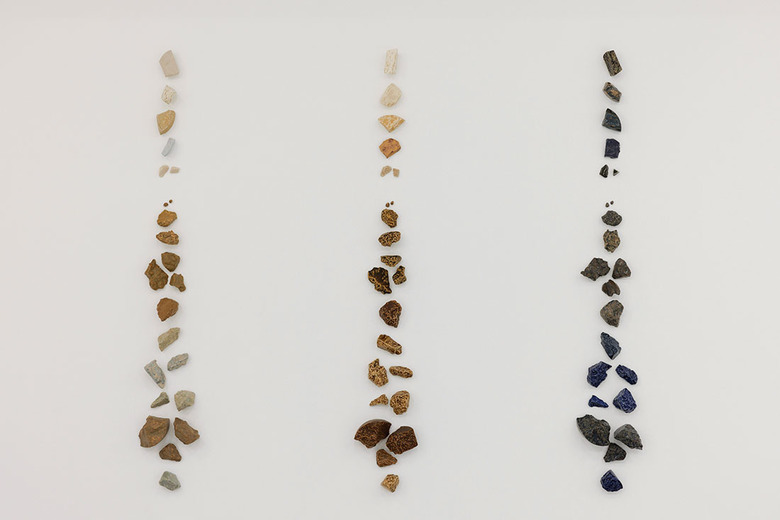
Yasmin Smith, Chicxulub,
2025, white stoneware with 45 data-derived glazes, 170.00 x 170.00 x 10.00 cm, TCG23746
(photo: Elle Fredericksen)
Chicxulub presents ceramic glazes and forms derived from the ground zero of earth’s fifth mass extinction event, the End Cretaceous - Paleogene extinction, at the impact zone of the Chicxulub crater. Through her collaboration with Professor Kliti Grice, and the Western Australian Organic & Isotope Geochemistry Centre, Curtin University, Smith obtained fifteen samples from a core drilling extending from the peak ring to a depth of 1.3km below the crater floor. Chicxulub presents cast ceramic replicas of the samples with a suite of ceramic glazes derived from the chemical analysis of each sample. These are presented in three vertical lines: the overall chemical glaze aesthetic on the left, the major elements in the centre and the trace elements on the right. In descending order, the first five samples of each vertical line come from the post-impact sediments, which washed back into the crater in the subsequent tsunamis, forming calcareous rock. At 620 meters below the surface the core passes through the extinction line. This is indicated by a break in the vertical lines and reflected in the sudden shift in the character of the glazes of the five samples below the extinction line, which belong to the target rocks. These rocks were chemically and physically altered by the severity of the asteroid impact, forming a type of melt-bearing impact rock called suevite breccia, containing shocked and unshocked fragments of rocks, minerals and glass, fused and cemented together. The lower five samples are the oldest basement rocks where at times melt-rock dikes cut through the formation — visible, for example, in the glaze of sample fourteen.
- » installation view: MA Art and Ecology Degree Show, Goldsmiths, University of London, London, 2025 | showing Yasmin Smith, Chicxulub, 2025
- » Yasmin Smith, Chicxulub, 2025 — installation view
- » Yasmin Smith, Chicxulub, 2025 — installation view
- » Yasmin Smith, Chicxulub, 2025 — installation view
- » Yasmin Smith, Chicxulub, 2025 — detail
- » Yasmin Smith, Chicxulub, 2025 — detail
- » Yasmin Smith, Chicxulub, 2025 — detail
- » Yasmin Smith, Chicxulub, 2025 — detail
- » Yasmin Smith, Chicxulub, 2025 — detail
- » Yasmin Smith, Chicxulub, 2025 — detail
- » Yasmin Smith, Chicxulub, 2025 — detail
- » Yasmin Smith, Chicxulub, 2025 — detail






